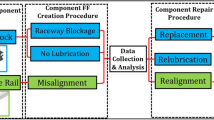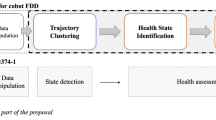Abstract
In the age of Industry 4.0, multi-axis robots are widely used in smart manufacturing thanks to their capacity of milling high complex forms and interacting with several systems in production lines. However, during manufacturing, the occurrence of small drifts in the robot arms may lead to critical failures and significant product quality damages and, therefore, high financial losses. Hence, this paper aims to develop an effective and practical methodology for online diagnostics of robot drifts based on information fusion of direct and indirect monitoring. The direct monitoring exploits the already installed encoders on each servomotor of the robot while the indirect monitoring uses heterogeneous sensors (current, vibration, force and torque) placed at the robot tool level. The sensor measurements of the robot tool are processed, in an offline phase, to build health indicators and fused to learn a classifier for drifts detection and diagnostics. Then, during the online phase and in the case of presence of new drift patterns, the encoder measurements are used to label these patterns and update the classifier learned previously to diagnose their origin. The efficiency and robustness of the proposed methodology are verified through a real industrial machining multi-axis robot that investigates different drift severities of its arms.











Similar content being viewed by others
Change history
14 February 2022
The original online version of this article was revised: Author name Kamal Medjaher has been corrected.
11 February 2022
A Correction to this paper has been published: https://doi.org/10.1007/s10845-022-01919-y
Abbreviations
- HIs :
-
Health indicators of the indirect monitoring
- \(HIs^{\prime }\) :
-
Normalized HIs
- \(\bar{HIs^{\prime }}\) :
-
Mean value of indirect monitoring \(HIs^\prime \)
- RMS :
-
Root Mean Square
- StD, \(\sigma \) :
-
Standard Deviation
- VAR :
-
Variance
- KUR :
-
Kurtosis
- \(y_{h}\) :
-
Raw signal segment
- \(y^{\prime }_{h}\) :
-
Normalized raw signal segment
- L :
-
Length of each signal segment \(y_{h}\)
- FFT :
-
Fast Fourier Transform
- Y :
-
Global raw signal
- Ne :
-
Number of signal segments
- h :
-
Ensemble of observations of each segment Ne
- \(\varOmega \) :
-
Class of observations of indirect monitoring
- AE :
-
Auto-Encoder
- f :
-
Encoding function of the AE
- g :
-
Decoding function of the AE
- w, b :
-
Weights and bias of the encoding layer
- \(w', b'\) :
-
Transposed w and b of the decoding layer
- \(O_{1}\) :
-
\(HIs^{\prime }\) input observations to the AE
- \(O_{2}\) :
-
Fused \(HIs^{\prime }\) through hidden layer encoding
- \(O_{3}\) :
-
Reconstructed \(HIs^{\prime }\) of AE output layer
- MSE :
-
Mean Square Error of \(O_1\) and \(O_3\)
- \(D_{O_{2}}\) :
-
Euclidean distance of \(HIs^{\prime }\) to class’s centroïd
- \(\bar{D_{O_{2}}}\) :
-
Mean of Euclidean distance of \(D_{O_{2}}\)
- \(P_{thr}\) :
-
Peripheral threshold of each \(HIs^{\prime }\) class
- C :
-
Centroïds of indirect monitoring
- n :
-
Number of encoder data observations
- error :
-
Position error of robot’s axes
- \(\bar{error}\) :
-
Mean of position error of robot’s axes
- s :
-
System health state
- \(Indi_{i}\) :
-
Direct monitoring indicator of the ith axis
References
Ali, J. B., & Saidi, L. (2018). A new suitable feature selection and regression procedure for lithium-ion battery prognostics. International Journal of Computer Applications in Technology, 58(2), 102–115.
Bhuiyan, M., Choudhury, I., & Dahari, M. (2014). Monitoring the tool wear, surface roughness and chip formation occurrences using multiple sensors in turning. Journal of Manufacturing Systems, 33(4), 476–487.
Cai, W., Wang, J., Jiang, P., Cao, L., Mi, G., & Zhou, Q. (2020). Application of sensing techniques and artificial intelligence-based methods to laser welding real-time monitoring: A critical review of recent literature. Journal of Manufacturing Systems, 57, 1–18.
Chen, X. W., & Nof, S. Y. (2007). Error detection and prediction algorithms: Application in robotics. Journal of Intelligent and Robotic Systems, 48(2), 225–252.
Cho, S., & Jiang, J. (2018). Optimal fault classification using fisher discriminant analysis in the parity space for applications to NPPS. IEEE Transactions on Nuclear Science, 65(3), 856–865.
Fatima, S., Mohanty, A., & Naikan, V. (2015). Multiple fault classification using support vector machine in a machinery fault simulator. In Vibration engineering and technology of machinery (pp. 1021–1031). Springer.
Gotlih, J., Brezocnik, M., Balic, J., Karner, T., Razborsek, B., & Gotlih, K. (2017). Determination of accuracy contour and optimization of workpiece positioning for robot milling. Advances in Production Engineering & Management, 12(3), 233–244.
Heinemann, R., Hinduja, S., & Barrow, G. (2007). Use of process signals for tool wear progression sensing in drilling small deep holes. The International Journal of Advanced Manufacturing Technology, 33(3–4), 243–250.
Hsieh, W. H., Lu, M. C., & Chiou, S. J. (2012). Application of backpropagation neural network for spindle vibration-based tool wear monitoring in micro-milling. The International Journal of Advanced Manufacturing Technology, 61(1–4), 53–61.
Jimenez, J. J. M., Schwartz, S., Vingerhoeds, R., Grabot, B., & Salaün, M. (2020). Towards multi-model approaches to predictive maintenance: A systematic literature survey on diagnostics and prognostics. Journal of Manufacturing Systems, 56, 539–557.
Khajavi, M. N., Nasernia, E., & Rostaghi, M. (2016). Milling tool wear diagnosis by feed motor current signal using an artificial neural network. Journal of Mechanical Science and Technology, 30(11), 4869–4875.
Kuric, I., Tlach, V., Ságová, Z., Císar, M., & Gritsuk, I. (2018). Measurement of industrial robot pose repeatability. In MATEC web of conferences (Vol. 244, pp. 1–9). EDP Sciences.
Lee, J., Bagheri, B., & Kao, H. A. (2015). A cyber-physical systems architecture for industry 4.0-based manufacturing systems. Manufacturing Letters, 3, 18–23.
Lin, P., & Tao, J. (2019) A novel bearing health indicator construction method based on ensemble stacked autoencoder. In 2019 IEEE international conference on prognostics and health management (ICPHM) (pp. 1–9). IEEE.
Loutas, T., Eleftheroglou, N., Georgoulas, G., Loukopoulos, P., Mba, D., & Bennett, I. (2019). Valve failure prognostics in reciprocating compressors utilizing temperature measurements, PCA-based data fusion, and probabilistic algorithms. IEEE Transactions on Industrial Electronics, 67(6), 5022–5029.
Madeti, S. R., & Singh, S. (2018). Modeling of PV system based on experimental data for fault detection using KNN method. Solar Energy, 173, 139–151.
Madhusudana, C., Kumar, H., & Narendranath, S. (2016). Condition monitoring of face milling tool using k-star algorithm and histogram features of vibration signal. Engineering Science and Technology, an International Journal, 19(3), 1543–1551.
Meng, T., Jing, X., Yan, Z., & Pedrycz, W. (2020). A survey on machine learning for data fusion. Information Fusion, 57, 115–129.
Mukherjee, S., & Sharma, N. (2012). Intrusion detection using Naive Bayes classifier with feature reduction. Procedia Technology, 4, 119–128.
Nguyen, K. T., & Medjaher, K. (2019). A new dynamic predictive maintenance framework using deep learning for failure prognostics. Reliability Engineering & System Safety, 188, 251–262.
Ogedengbe, T. I., Heinemann, R., Hinduja, S., et al. (2011). Feasibility of tool condition monitoring on micro-milling using current signals. AU JT, 14(3), 161–172.
Pivoto, D. G., de Almeida, L. F., da Rosa, Righi R., Rodrigues, J. J., Lugli, A. B., & Alberti, A. M. (2021). Cyber-physical systems architectures for industrial internet of things applications in industry 4.0: A literature review. Journal of Manufacturing Systems, 58, 176–192.
Qiao, G., & Weiss, B. A. (2017). Accuracy degradation analysis for industrial robot systems. In Proceedings of ASME international manufacturing science and engineering conference (pp. 1–9).
Qiao, G., Schlenoff, C., & Weiss, B. A. (2017). Quick positional health assessment for industrial robot prognostics and health management (PHM). In 2017 IEEE international conference on robotics and automation (ICRA) (pp. 1815–1820). IEEE.
Qiao, G., & Weiss, B. A. (2018). Quick health assessment for industrial robot health degradation and the supporting advanced sensing development. Journal of Manufacturing Systems, 48, 51–59.
Ratava, J., Lohtander, M., & Varis, J. (2017). Tool condition monitoring in interrupted cutting with acceleration sensors. Robotics and Computer-Integrated Manufacturing, 47, 70–75.
Samantaray, S. (2009). Decision tree-based fault zone identification and fault classification in flexible AC transmissions-based transmission line. IET Generation, Transmission & Distribution, 3(5), 425–436.
Segreto, T., Karam, S., Teti, R., & Ramsing, J. (2015). Feature extraction and pattern recognition in acoustic emission monitoring of robot assisted polishing. Procedia CIRP, 28, 22–27.
Selvaraj, D. P., Chandramohan, P., & Mohanraj, M. (2014). Optimization of surface roughness, cutting force and tool wear of nitrogen alloyed duplex stainless steel in a dry turning process using Taguchi method. Measurement, 49, 205–215.
Shi, X., Wang, X., Jiao, L., Wang, Z., Yan, P., & Gao, S. (2018). A real-time tool failure monitoring system based on cutting force analysis. The International Journal of Advanced Manufacturing Technology, 95(5–8), 2567–2583.
Soualhi, M., Nguyen, K., Medjaher, K., Lebel, D., & Cazaban, D. (2019a). Health indicator construction for system health assessment in smart manufacturing. In 2019 prognostics and system health management conference (PHM-Paris) (pp. 45–50). IEEE.
Soualhi, M., Nguyen, K. T., & Medjaher, K. (2020). Pattern recognition method of fault diagnostics based on a new health indicator for smart manufacturing. Mechanical Systems and Signal Processing, 142, 1–20.
Soualhi, M., Nguyen, K. T., Soualhi, A., Medjaher, K., & Hemsas, K. E. (2019b). Health monitoring of bearing and gear faults by using a new health indicator extracted from current signals. Measurement, 141, 37–51.
Terrazas, G., Martínez-Arellano, G., Benardos, P., & Ratchev, S. (2018). Online tool wear classification during dry machining using real time cutting force measurements and a CNN approach. Journal of Manufacturing and Materials Processing, 2(4), 1–18.
Tobon-Mejia, D., Medjaher, K., & Zerhouni, N. (2012). CNC machine tool’s wear diagnostic and prognostic by using dynamic Bayesian networks. Mechanical Systems and Signal Processing, 28, 167–182.
Wang, Y., Zheng, L., & Wang, Y. (2021). Event-driven tool condition monitoring methodology considering tool life prediction based on industrial internet. Journal of Manufacturing Systems, 58, 205–222.
Acknowledgements
The project has been 65% cofinanced by the European Regional Development Fund (ERDF) through the Interreg V-A Spain France Andorra programme (POCTEFA 2014-2020). POCTEFA aims to reinforce the economic and social integration of the French-Spanish-Andorran border. Its support is focused on developing economic, social and environmental cross-border activities through joint strategies favouring sustainable territorial development.
Author information
Authors and Affiliations
Corresponding author
Additional information
Publisher's Note
Springer Nature remains neutral with regard to jurisdictional claims in published maps and institutional affiliations.
The original online version of this article was revised: The author name Kamal Medjaher has been corrected.
Rights and permissions
About this article
Cite this article
Soualhi, M., Nguyen, K.T.P., Medjaher, K. et al. Intelligent monitoring of multi-axis robots for online diagnostics of unknown arm deviations. J Intell Manuf 34, 1743–1759 (2023). https://doi.org/10.1007/s10845-021-01882-0
Received:
Accepted:
Published:
Issue Date:
DOI: https://doi.org/10.1007/s10845-021-01882-0




